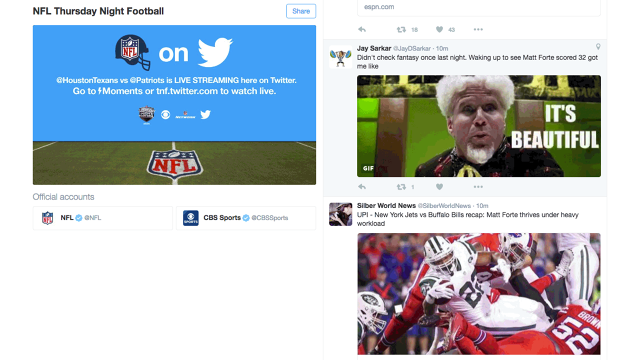My Parents’ Review of Twitter’s NFL Broadcast
Last night, Twitter streamed the first of 10 Thursday-night football games that it has bought the rights to air this season. Hosting NFL games is part of a wider strategy to woo new users to the social network: The game, like other live events on Twitter, was broadcast next to a running stream of tweets that a new user could consume without necessarily understanding the nuances of hashtags, @ mentions, and other of Twitter’s less-than-intuitive conventions.
The idea is to showcase Twitter as a complement to news rather than as a social network, and to show people who aren’t interested in, say, sharing baby pictures, why they should use the product. Twitter reportedly paid between $10 million and $15 million for rights to stream the games.

To understand whether Twitter accomplished its goal of approachability for people who don’t typically use the platform, I turned to the lifelong football fans I know best: My parents, who taught me that calling people during Sunday games is as rude as calling on Christmas.
“Would I watch it on my laptop?” My dad asks me when I request that he watch the game on Twitter.
Twitter has made its version of the game available on its mobile app, its desktop product, and in its apps for the Apple TV, Amazon Fire TV, and Xbox. My dad opts for the laptop. My mom watches on her iPad. Neither has any trouble navigating to the game from the link I send them (Twitter doesn’t require viewers sign up or sign in to watch). Though my parents were watching in the same room, I interviewed them individually via text message.
“It’s kind of hard to go back and forth from [the stream] to the tweets,” my dad says as soon as he pulls up the game. “It might be fun to have video on TV and watch the tweets on a PC.”
This, I tell him, is what many people do with Twitter while watching all sorts of events, even if they’re not streamed live on Twitter. Has he thought about tweeting?
“There are so many tweets,” He says. “You might as well put a note in a bottle and throw it into Lake Michigan.” (We’re Midwesterners).
My mom is a little more open to the idea. “[It’s] a little pixilated at times,” she says, “overall a good option if you don’t want to pay for NFL Network [the league’s 24-hour network].”
Do the tweets add anything?
“It’s like yelling at the TV,” she says. “If you’re alone without someone to share your excitement and frustration with, it could compensate.”
I tell her that dad doesn’t think these tweets are adding anything: “He doesn’t yell at the TV,” she says.
My father concedes that “It would be nice if you were traveling and local TV wasn’t carrying a game you wanted to see. A lot of the tweets mention they like this.”
“I don’t even know how a hashtag works,” my mom says.
This is a problem for Twitter—and one this live setup to some extent solves. Viewers can consume the conversation around an event without necessarily knowing how it’s organized. I tell her hashtags work like a filing system. “And then, why do I care what random strangers tweet?” she asks.
It’s interesting commentary, maybe?
“The tweets are moronic,” my father concludes.
“He thinks the tweets are moronic,” I tell my mom.
“He doesn’t do fantasy football either,” she says. “He liked the tweets during the debates.”
Oh reaaalllllly? I had no idea that my dad watched the presidential primary debates with Twitter open (the site also live-streamed the Republican and Democratic debates on its platform). Or that my dad ever opened Twitter.
“The tweets here are shallow and not thought-provoking,” he tells me when I tell him what I’ve learned from mom. “In the debates, it was more interesting.”
Coming from a non-nerd who—like most non-nerds—doesn’t get hashtags and doesn’t see the point in tweeting, even if Twitter football doesn’t turn out to be my dad’s thing, I’d chalk this up as a success for Twitter’s live events strategy.
Fast Company , Read Full Story
(15)













